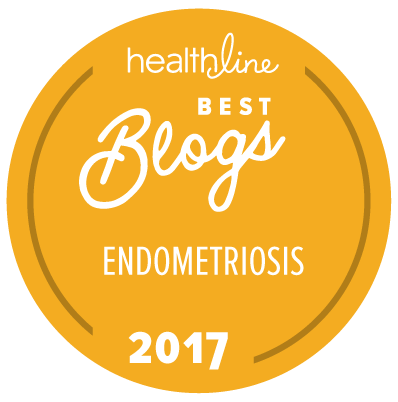What is Endometriosis?
I'm really lazy, so I'm going to copy and paste the definition of endometriosis from The Endometriosis Foundation of America.
During monthly menstruation, the female body sheds the endometrium - uterine lining - in the process commonly known as a "period". In women and girls who have endometriosis, some of these menstrual fluids are retained in the body and abnormally implant in areas outside of the uterus. These implants, or nodules, eventually accumulate on the bladder, bowel, ovaries, cul de sac, and other nearby organs, leading to the development of adhesions, scarring and invasive nodules. This can cause symptoms that vary from painful periods, chronic pelvic pain, infertility, pain associated with intercourse and sexual activity to painful bowel movements, rectal pain and urinary pain or difficulty.
A common myth about endometriosis is that the more endometrial cells accumulated in the body outside of the uterine cavity, the more pain it causes for the woman. Any amount of endometriosis can cause pain, and the disease does not need to be advanced to cause significant symptoms. Likewise, higher stage (3 and 4) disease may cause little to no symptoms in some women. Situations vary; moderate growth can trigger intense pain in some women while advanced growth causes less severe pain in others. Every woman's situation is unique and therefore expert medical evaluation is absolutely essential.
No consensus has been reached on the definitive cause of endometriosis, though stem cells, genetics, dysfunctional immune response, and environmental triggers may all be part of the multi-factorial origin of the disease. A woman or girl with a mother who has endometriosis is seven times more likely to have the disease herself; endometriosis is also associated with other autoimmune disorders such as thyroid disease.
Despite the confusion and misinformation continuing to surround the disease, the profound, agonizing pain caused by endometriosis is actually treatable, and in many cases quite successfully. Unfortunately, due to a lack of societal and medical community awareness, women are frequently directed to "manage" their discomfort for years with powerful painkillers and hormones - but these only mask symptoms of the condition. What's more, many patients are incorrectly informed by their doctors and treated for symptoms but not endometriosis, which consequently causes a long delay in effective treatment. This dangerous result has led to many "hit or miss" surgeries and thousands of unnecessary hysterectomies. Laparoscopic Excision Surgery - deep removal of all disease from all areas including bowel, bladder and beyond - is an effective, organ-sparing option; ideally performed by experienced, specialized surgeons with dedicated, multidisciplinary medical teams.
Endometriosis Facts & Statistics
- Most women with endometriosis suffer pain—and present symptoms—up to a full decade prior to diagnosis.
- Approximately 176 million women and girls worldwide suffer from endometriosis; 8.5 million in North America alone.
- Associated costs of the disease are estimated to be a staggering $22 billion annually.
- The average woman is 27 when she is first diagnosed with endometriosis.
- Endometriosis is one of the top three causes of female infertility. While it is one of the most treatable, it remains the least treated.
- Abdominal and bowel symptoms linked to endometriosis are commonly misdiagnosed as Irritable Bowel Syndrome (IBS).
- Endometriosis is often misdiagnosed as Pelvic Congestion or Pelvic Inflammatory Disease (PID).
- Many infertile women with endometriosis experienced debilitating painful periods as teenagers but were misdiagnosed.
- Many women suffer silently because they feel that their pain, especially pain associated with sexual intercourse, is just too personal to discuss with their gynecologist. This is more common in some cultures than others.
- Many cases of endometriosis can be successfully treated with Laparoscopic Excision Surgery. Hysterectomy should only ever be considered as a last resort. There is no oral medication to cure endometriosis.
Symptoms of Endometriosis
Endometriosis is much more than simple “killer cramps.” It can cause symptoms varying from painful periods (called dysmenorrhea), to pain with sexual activity (referred to as dyspareunia), to gastrointestinal and urinary tract difficulties (respectively referred to as dyschezia and dysuria). Infertility is also prevalent in endometriosis, affecting more than half of women who have the disease. Some characteristic signs of endometriosis include:
- chronic or intermittent pelvic pain
- painful menstruation
- irregular vaginal or uterine bleeding
- irregular vaginal clotting
- large, painful ovarian cysts called endometriomas or "chocolate cysts"
- infertility, miscarriage, ectopic (tubal) pregnancy
- pain associated with intercourse
- nausea/vomiting, gastrointestinal cramping, diarrhea/constipation, particularly with periods
- rectal pain
- blood in the urine; urinary frequency, retention, or urgency
- fatigue, chronic pain, allergies and other immune-related issues are also commonly reported complaints in those with endometriosis
To learn about how I was diagnosed with endometriosis, click on these links:









